Submitted:
16 July 2024
Posted:
17 July 2024
You are already at the latest version
Abstract
Keywords:
1. Introduction
2. Materials and Methods
2.1. Materials
2.2. Preparation of Panels
2.3. Characterization of the MDF Panels
2.4. Statistical Analysis
3. Results and Discussion
3.1. Determination of Modulus of Modulus of Elasticity in Bending and of Bending Strength
3.2. Water Absorption and Thickness Swelling
3.3. Thermal Properties
3.4. Screw Withdrawal Resistance
3.5. Internal Bond
3.6. Density Profiles
4. Conclusions
Author Contributions
Funding
Institutional Review Board Statement
Informed Consent Statement
Data Availability Statement
Acknowledgments
Conflicts of Interest
References
- Tang, X.; Zhao, T.; Hou, D.; Yu, C.W. Challenges and paths to enhance green efficiency under low-carbon economic and social development. Indoor Built Environ. 2023. [Google Scholar] [CrossRef]
- Vetter, S.; Nayak, D.; Mcbey, D.; Dondini, M.; Kuhnert, M.; Oyesiku-Blakemore, J. Environmental Issues: Greenhouse Gas Emissions. In; 2022 ISBN 9780081005965.
- Feulner, G. Global Challenges: Climate Change. Glob. Challenges 2017, 1, 5–6. [Google Scholar] [CrossRef] [PubMed]
- Mckibbin, W.J. The Problem With Internationally Tradeable Emission Permits for Greenhouse Gas Abatement 1997.
- Cunha, J.P. da; Eames, P. Thermal energy storage for low and medium temperature applications using phase change materials – A review. 2016. [CrossRef]
- Zhang, N.; Yuan, Y.; Cao, X.; Du, Y.; Zhang, Z.; Gui, Y. Latent Heat Thermal Energy Storage Systems with Solid–Liquid Phase Change Materials: A Review. 2018. [CrossRef]
- Temiz, A.; Hekimoglu, G.; Demirel, G.K.; Sarı, A.; Amini, M.H.M. Phase change material impregnated wood for passive thermal management of timber buildings. 2020. [CrossRef]
- Wróblewski, P.; Niekurzak, M. Assessment of the Possibility of Using Various Types of Renewable Energy Sources Installations in Single-Family Buildings as Part of Saving Final Energy Consumption in Polish Conditions. Energies 2022, 15. [Google Scholar] [CrossRef]
- Chun-sheng, Z.; Shu-wen, N.I.U.; Xin, Z. Effects of household energy consumption on environment and its influence factors in rural and urban areas. Energy Procedia 2012, 14. [Google Scholar] [CrossRef]
- Rai, A.; Kushwaha, P.; Pandey, N.; Pandey, S.; Gupta, N.; Saran, O. A Robust Hybrid Deep Learning Model for Wind Power Forecasting. In Proceedings of the 2023 3rd International Conference on Advance Computing and Innovative Technologies in Engineering, ICACITE 2023; 2023; pp. 2009 – 2012.
- Wang, Z.; Ning, H.; Ji, Y.; Hou, J.; He, Y. Human thermal physiological and psychological responses under different heating environments. J. Therm. Biol. 2015, 52, 177–186. [Google Scholar] [CrossRef] [PubMed]
- Lin, K.; Zhang, Y.; Xu, X.; Di, H.; Yang, R.; Qin, P. Experimental study of under-floor electric heating system with shape-stabilized PCM plates. 2005. [CrossRef]
- Aftab, W.; Usman, A.; Shi, J.; Yuan, K.; Qin, M.; Zou, R. Phase change material-integrated latent heat storage systems for sustainable energy solutions. Energy Environ. Sci. 2021, 14, 4268–4291. [Google Scholar] [CrossRef]
- Wu, S.; Yan, T.; Kuai, Z.; Pan, W. Thermal conductivity enhancement of phase change materials for thermal energy storage: a review. 2019. [Google Scholar] [CrossRef]
- Sharma, A.; Tyagi, V..; Chen, C.R.; Buddhi, D. Review on thermal energy storage with phase change materials and applications. Renew. Sustain. Energy Rev. 2009, 318–345. [CrossRef]
- Lizana, J.; Chacartegui, R.; Barrios-Padura, A.; Valverde, J.M. Advances in thermal energy storage materials and their applications towards zero energy buildings: A critical review. Appl. Energy 2017, 203, 219–239. [Google Scholar] [CrossRef]
- Hussain, A.; Abidi, I.H.; Tso, C.Y.; Chan, K.C.; Luo, Z.; Chao, C.Y.H. Thermal management of lithium ion batteries using graphene coated nickel foam saturated with phase change materials. Int. J. Therm. Sci. 2018, 124, 23–35. [Google Scholar] [CrossRef]
- Li, G.; Hong, G.; Dong, D.; Song, W.; Zhang, X. Multiresponsive Graphene-Aerogel-Directed Phase-Change Smart Fibers. 2018. [CrossRef]
- Lian, Q.; Li, Y.; Sayyed, A.A.S.; Cheng, J.; Zhang, J. Facile Strategy in Designing Epoxy/Paraffin Multiple Phase Change Materials for Thermal Energy Storage Applications. ACS Sustain. Chem. Eng. 2018, 6, 3375–3384. [Google Scholar] [CrossRef]
- Min, P.; Liu, J.; Li, X.; An, F.; Liu, P.; Shen, Y.; Koratkar, N.; Yu, Z.-Z. Thermally Conductive Phase Change Composites Featuring Anisotropic Graphene Aerogels for Real-Time and Fast-Charging Solar-Thermal Energy Conversion. 2018. [CrossRef]
- Jebasingh, E.; Arasu, V. A comprehensive review on latent heat and thermal conductivity of nanoparticle dispersed phase change material for low-temperature applications. 2019. [Google Scholar] [CrossRef]
- Cárdenas, B.; León, N. High temperature latent heat thermal energy storage: Phase change materials, design considerations and performance enhancement techniques. Renew. Sustain. Energy Rev. 2013, 27, 724–737. [Google Scholar] [CrossRef]
- Rao, Z.; Wang, S.; Zhang, Z. Energy saving latent heat storage and environmental friendly humidity-controlled materials for indoor climate. Renew. Sustain. Energy Rev. 2012, 16, 3136–3145. [Google Scholar] [CrossRef]
- Memon, S.A. Phase change materials integrated in building walls: A state of the art review. Renew. Sustain. Energy Rev. 2014, 31, 870–906. [Google Scholar] [CrossRef]
- Al-Absi, Z.A.; Isa, M.H.M.; Ismail, M. Phase Change Materials (PCMs) and Their Optimum Position in Building Walls. 2020. [CrossRef]
- Sun, X.; Jovanovic, J.; Zhang, Y.; Fan, S.; Chu, Y.; Mo, Y.; Liao, S. Use of encapsulated phase change materials in lightweight building walls for annual thermal regulation. 2019. [CrossRef]
- Santos-Herrero, J.M.; Lopez-Guede, J.M.; Flores, I. A Short review on the use of renewable energies and model predictive control in buildings. J. Energy Syst. 2017, 1, 112–119. [Google Scholar] [CrossRef]
- Frahat, N.B.; Ustaoglu, A.; Gencel, O.; Sarı, A.; Hekimoğlu, G.; Yaras, A.; del Coz Díaz, J.J. Fuel, cost, energy efficiency and CO2 emission performance of PCM integrated wood fiber composite phase change material at different climates. Sci. Rep. 2023, 13. [Google Scholar] [CrossRef] [PubMed]
- Can, A.; Lee, S.H.; Antov, P.; Abd Ghani, M.A. Phase-Change-Material-Impregnated Wood for Potential Energy-Saving Building Materials. Forests 2023, 14. [Google Scholar] [CrossRef]
- Al-Absi, Z.A.; Hafizal, M.I.M.; Ismail, M. Experimental study on the thermal performance of PCM-based panels developed for exterior finishes of building walls. J. Build. Eng. 2022, 52, 104379. [Google Scholar] [CrossRef]
- Akpenpuun, T.D.; Gbadeyanka, R. Strength and micro-structural properties of wood chips composite panel. BioResources 2020, 15, 1861–1876. [Google Scholar] [CrossRef]
- Hartig, J.U.; Haller, P. Combustion characteristics and mechanical properties of wood impregnated with a paraffinic phase change material. 2023. [CrossRef]
- Kumar, B.; Balwani, A.; Agrawal, N.; Sasidharan, V.; Christy, J.V. Experimental Validation of PCM Integrated Space Heating Bhuvnesh. 2023. [CrossRef]
- Guimarães, T.C.; Gomes, O. da F.M.; Araújo, O.M.O. de; Lopes, R.T.; Da-Gloria, M.Y.R.; Filho, R.D.T.; Koenders, E.; Caggiano, A.; Mankel, C.; Sam, M.N.; et al. PCM-Impregnated Textile-Reinforced Cementitious Composite for Thermal Energy Storage. 2023. [CrossRef]
- Kudachi, B.; Mashilkar, B.; Varkute, N.; Mawalankar, O.; Shanbhag, A.; Gaikwad, S.; Camillus, A. Experimental Study of PCM Based Latent Heat Thermal Energy Storage System Using Fins. 2023, 789–801. [CrossRef]
- Djeffal, R.; Cherier, M.K.; Bekkouche, S.M.E.A.; Younsi, Z.; Hamdani, M.; Al-Saadi, S. Concept development and experimentation of a Phase Change Material (PCM) enhanced domestic hot water. J. Energy Storage 2022, 51. [Google Scholar] [CrossRef]
- Mohseni, M.; Alkhayyat, A.; Srikaanth, P.B.; Alrubaie, A.J.; Alguno, A.C.; Capangpangan, R.Y.; Singh, B.K. Analyzing Characteristics for Two-Step SET Operation Scheme for Improving Write Time in Nanoscale Phase-Change Memory (PCM). 2022. [CrossRef]
- Fabiani, C.; Pisello, A.L.; D’Alessandro, A.; Ubertini, F.; Cabeza, L.F.; Cotana, F. Effect of PCM on the hydration process of cement-based mixtures: A novel thermo-mechanical investigation. Materials (Basel). 2018, 11. [Google Scholar] [CrossRef] [PubMed]
- Yang, H.; Wang, Y.; Yu, Q.; Cao, G.; Yang, R.; Ke, J.; Di, X.; Liu, F.; Zhang, W.; Wang, C. Composite phase change materials with good reversible thermochromic ability in delignified wood substrate for thermal energy storage. Appl. Energy 2018, 212, 455–464. [Google Scholar] [CrossRef]
- Ma, L.; Wang, Q.; Li, L. Delignified wood/capric acid-palmitic acid mixture stable-form phase change material for thermal storage. Sol. Energy Mater. Sol. Cells 2019, 194, 215–221. [Google Scholar] [CrossRef]
- Cheng, L.; Feng, J. Form-stable phase change materials based on delignified wood flour for thermal management of buildings. Compos. Part A Appl. Sci. Manuf. 2020, 129, 105690. [Google Scholar] [CrossRef]
- Jeong, S.G.; Jeon, J.; Seo, J.; Lee, J.H.; Kim, S. Performance evaluation of the microencapsulated PCM for wood-based flooring application. Energy Convers. Manag. 2012, 64, 516–521. [Google Scholar] [CrossRef]
- Kirilovs, E.; Zotova, I.; Kukle, S.; Pugovičs, K. Low density hemp shive particleboards for latent thermal energy storage performance. J. Energy Syst. 2021. [Google Scholar] [CrossRef]
- Yang, H.; Chao, W.; Di, X.; Yang, Z.; Yang, T.; Yu, Q.; Liu, F.; Li, J.; Li, G.; Wang, C. Multifunctional wood based composite phase change materials for magnetic-thermal and solar-thermal energy conversion and storage. Energy Convers. Manag. 2019, 200, 112029. [Google Scholar] [CrossRef]
- EN 323 Wood-based panels - Determination of density; European Committee for Standardization, Brussels, Belgium, 1993.
- EN 310 Wood-Based Panels. Determination of Modulus of Elasticity in Bending and of Bending Strength; European Committee for Standardization, Brussels, Belgium, 1993;
- EN 319 Particleboards and fibreboards - Determination of tensile strength perpendicular to the plane of the board; European Committee for Standardization, Brussels, Belgium, 1993;
- EN 320 Particleboards and fibreboards - Determination of resistance to axial withdrawal of screws; European Committee for Standardization, Brussels, Belgium, 2011;
- EN 317 Particleboards and fiberboards – Determination of swelling in thickness after immersion in water; European Committee for Standardization, Brussels, Belgium, 1993;
- EN 622-5 Fiberboards. Specifications. Requirements for dry process boards (MDF); European Committee for Standardization: Brussels, Belgium, 2009.
- Rodríguez, G.E.; Bustos Ávila, C.; Cloutier, A. Physical and Mechanical Properties of Fiberboard Made of MDF Residues and Phase Change Materials. Forests 2024, 15, 1–16. [Google Scholar] [CrossRef]
- Wronka, A.; Kowaluk, G. The Influence of Multiple Mechanical Recycling of Particleboards on Their Selected Mechanical and Physical Properties. Materials (Basel). 2022, 15. [Google Scholar] [CrossRef] [PubMed]
- Bütün Buschalsky, F.Y.; Mai, C. Repeated thermo-hydrolytic disintegration of medium density fibreboards (MDF) for the production of new MDF. Eur. J. Wood Wood Prod. 2021, 79, 1451–1459. [Google Scholar] [CrossRef]
- Padala, S.K.; Deshpande, S.J.; Bhattacharjee, B. Assessment of setting characteristics, water absorption, thermal performance and compressive strength of energy-efficient phase change material (PCM)–ashcrete blocks. Sadhana - Acad. Proc. Eng. Sci. 2021, 46. [Google Scholar] [CrossRef]
- Wu, Y.-M.; Lu, S.-G.; Zhao, L.-Y.; Tang, Z.-Q.; Yang, N. Correlation between Characteristic Parameters of Vertical Density Profile and Main Physical and Mechanical Properties of Medium Density Fiberboard. Chinese J. Wood Sci. Technol. 2021, 35, 31–37. [Google Scholar] [CrossRef]
- Rodríguez, G.E.; Bustos Ávila, C.; Romero, R.; Cloutier, A. Impregnation of Medium-Density Fiberboard Residues with Phase Change Materials for Efficient Thermal Energy Storage. Forests 2023, 14. [Google Scholar] [CrossRef]
- Mathis, D.; Blanchet, P.; Landry, V.; Lagière, P. Thermal characterization of bio-based phase changing materials in decorative wood-based panels for thermal energy storage. Green Energy Environ. 2019, 4, 56–65. [Google Scholar] [CrossRef]
- Qi, C.; Zhang, F.; Mu, J.; Zhang, Y.; Yu, Z. Enhanced mechanical and thermal properties of hollow wood composites filled with phase-change material. J. Clean. Prod. 2020, 256, 120373. [Google Scholar] [CrossRef]
- Arce, M.E.; Feijoo, M.A.A.; Garcia, A.S.; Luhrs, C.C. Novel formulations of phase change materials-epoxy composites for thermal energy storage. Materials (Basel). 2018, 11. [Google Scholar] [CrossRef] [PubMed]
- Borysiewicz, I.; Kowaluk, G. Selected properties of MDF boards bonded with various fractions of recycled HDPE particles. Ann. WULS, For. Wood Technol. 2023, 123, 18–29. [Google Scholar] [CrossRef]
- Que, L.; Zhang, X.; He, X. The phase change hysteresis characteristics of Na2HPO4·12H2O: A molecular dynamics study. J. Mol. Liq. 2022, 359. [Google Scholar] [CrossRef]
- Cherkashina, H.M.; Avramenko, V.L.; Karandashov, O.H. Investigation of the effect of structuring methods on the change in residul stresses in polymer composite material. East Eur. J. Phys. 2020, 2020, 127–135. [Google Scholar] [CrossRef]
- Hosseinpourpia, R.; Adamopoulos, S.; Mai, C.; Taghiyari, H.R. Properties of medium-density fibreboards bonded with dextrin-based wood adhesive. Wood Res. 2019, 64, 185–194. [Google Scholar]
- Sawata, K.; Shibusawa, T.; Ohashi, K.; Castellanos, J.R.S.; Hatano, Y. Effects of density profile of MDF on stiffness and strength of nailed joints. J. Wood Sci. 2008, 54, 45–53. [Google Scholar] [CrossRef]
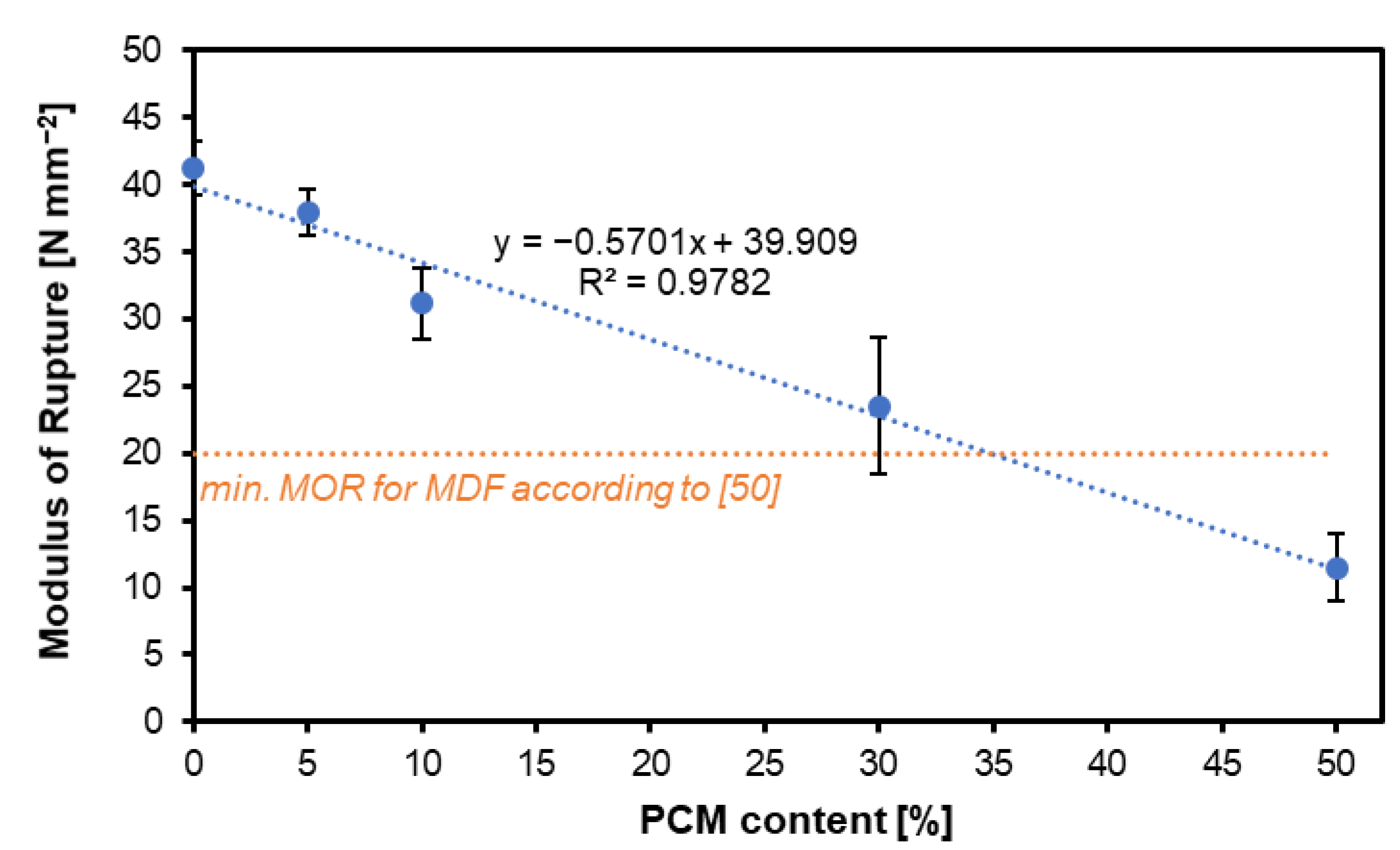
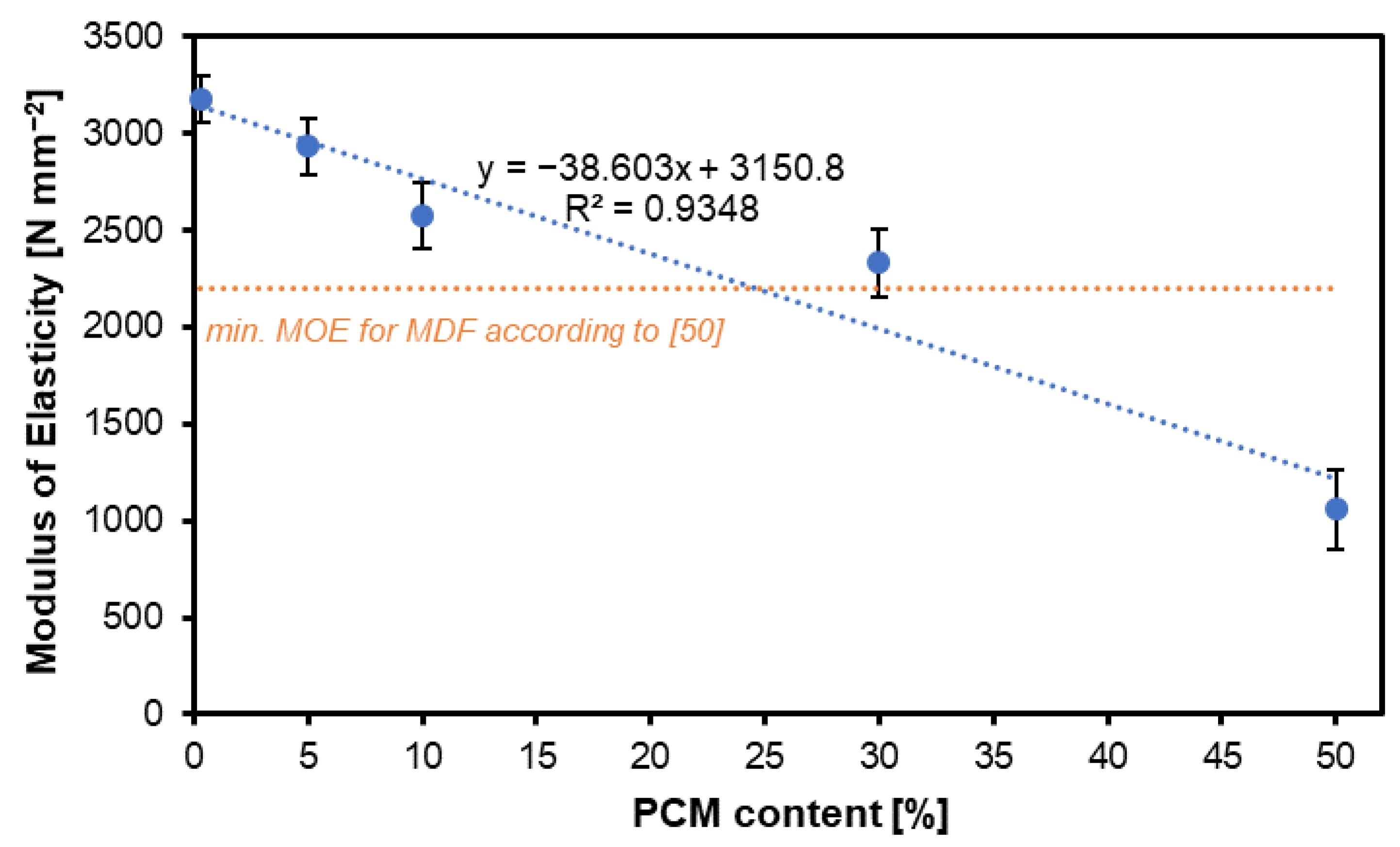
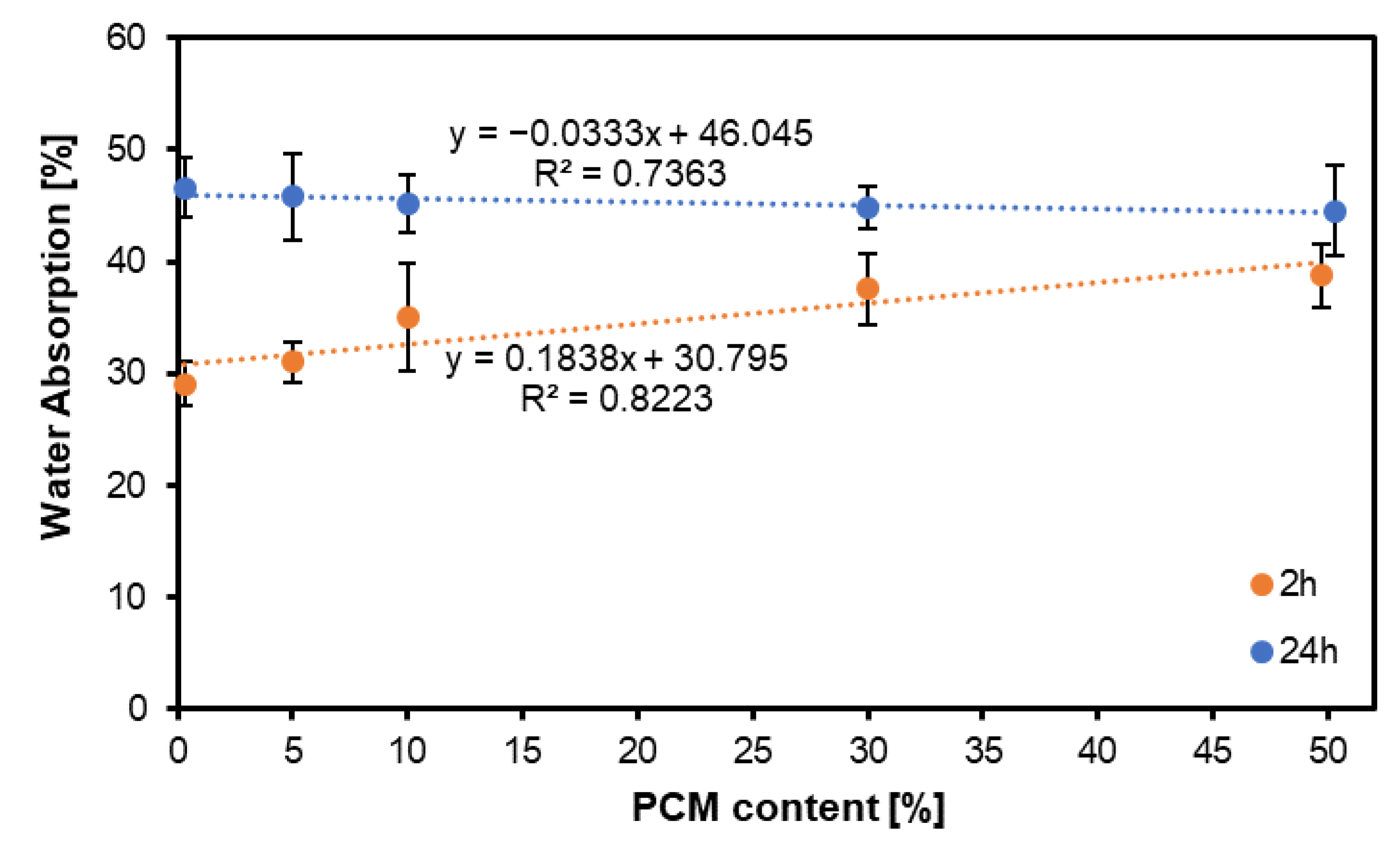
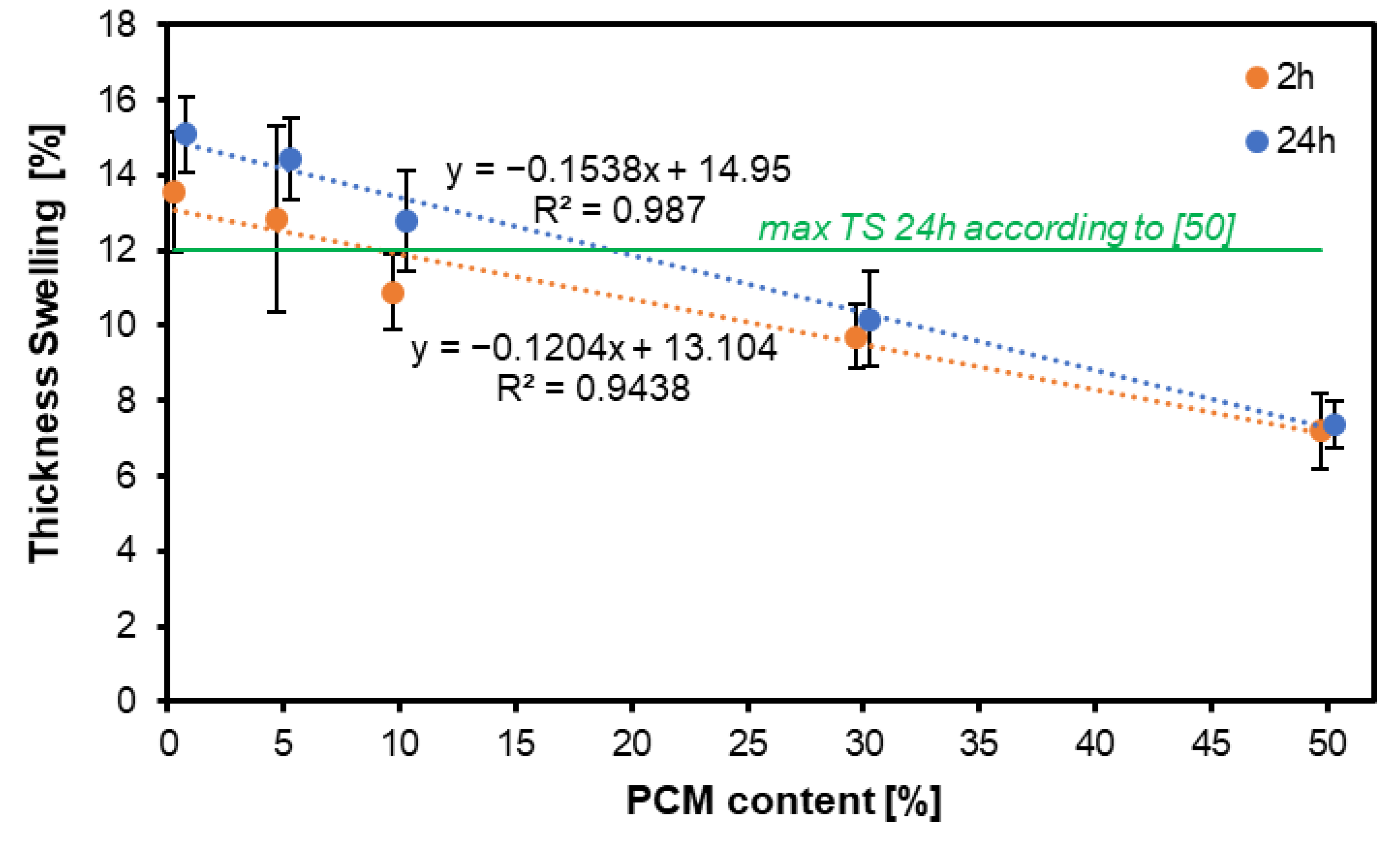
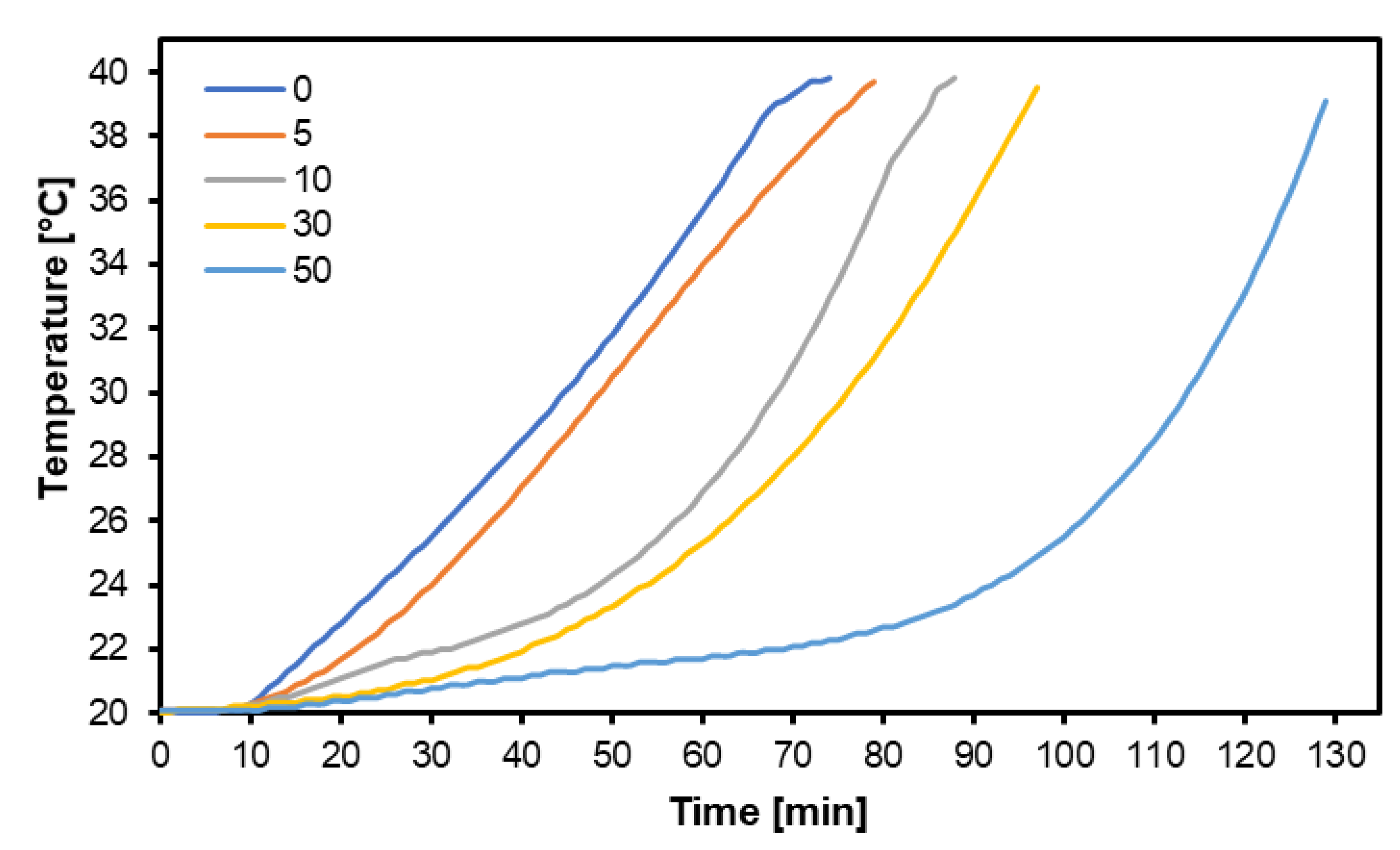
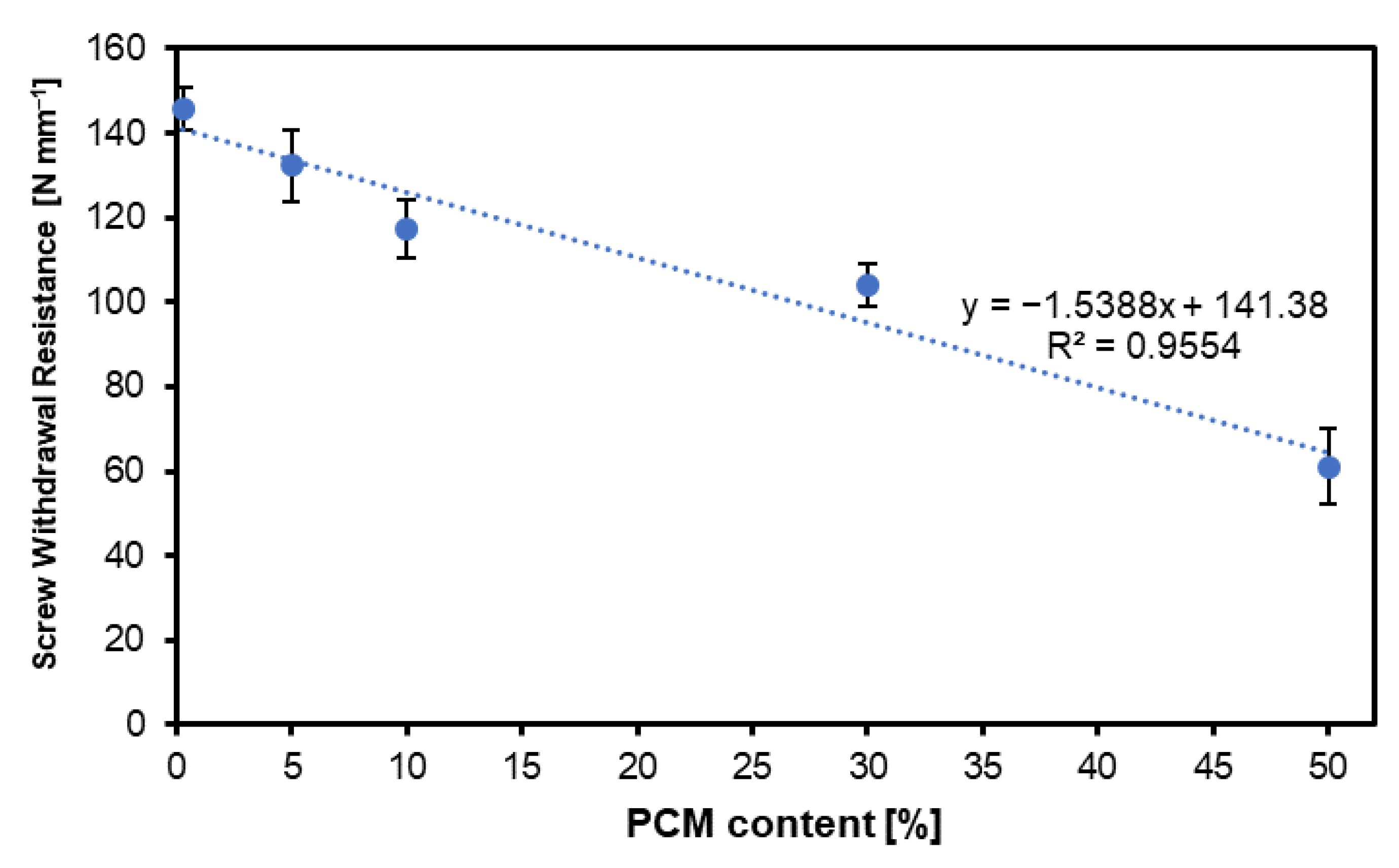
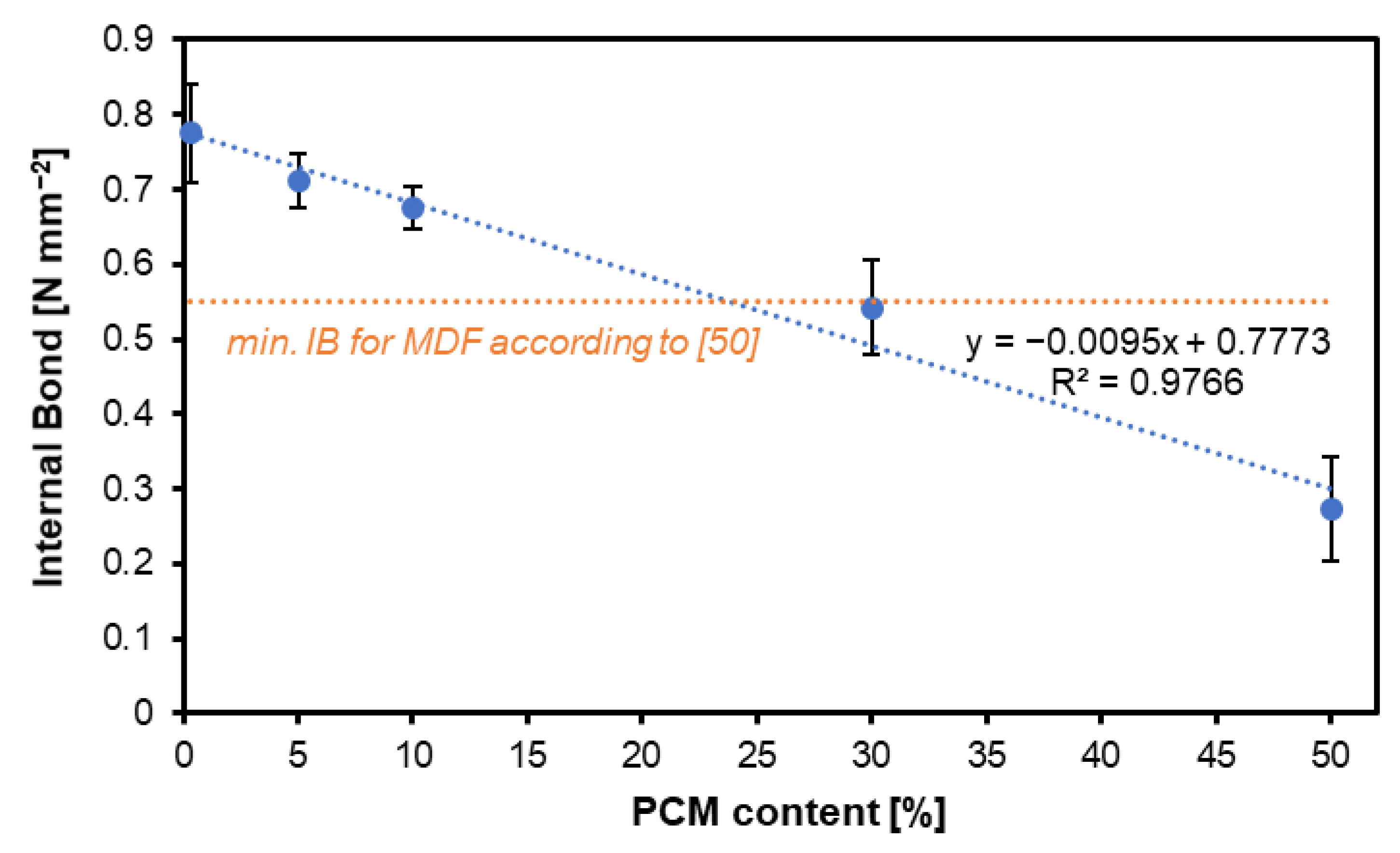
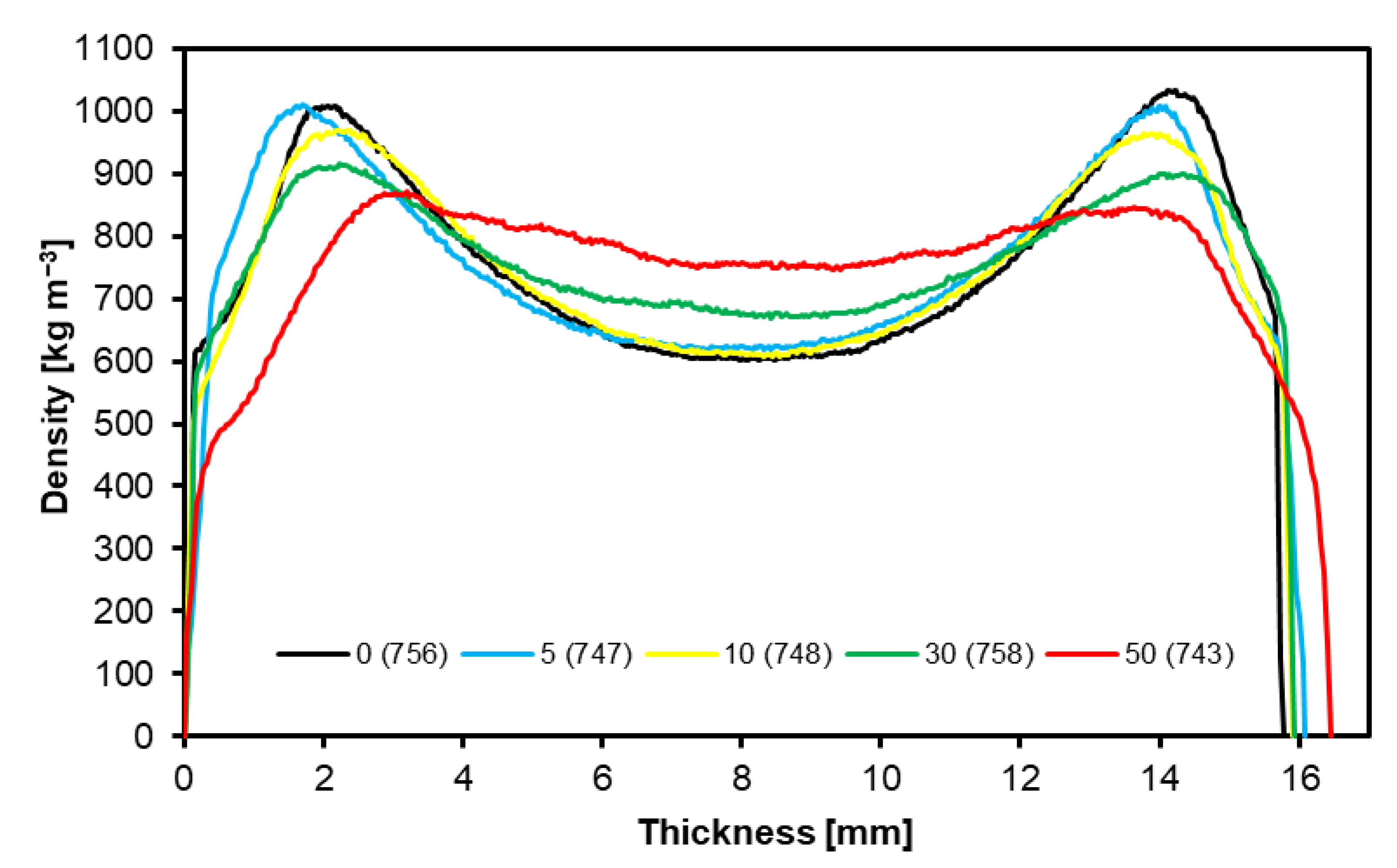
Disclaimer/Publisher’s Note: The statements, opinions and data contained in all publications are solely those of the individual author(s) and contributor(s) and not of MDPI and/or the editor(s). MDPI and/or the editor(s) disclaim responsibility for any injury to people or property resulting from any ideas, methods, instructions or products referred to in the content. |
© 2024 by the authors. Licensee MDPI, Basel, Switzerland. This article is an open access article distributed under the terms and conditions of the Creative Commons Attribution (CC BY) license (http://creativecommons.org/licenses/by/4.0/).




